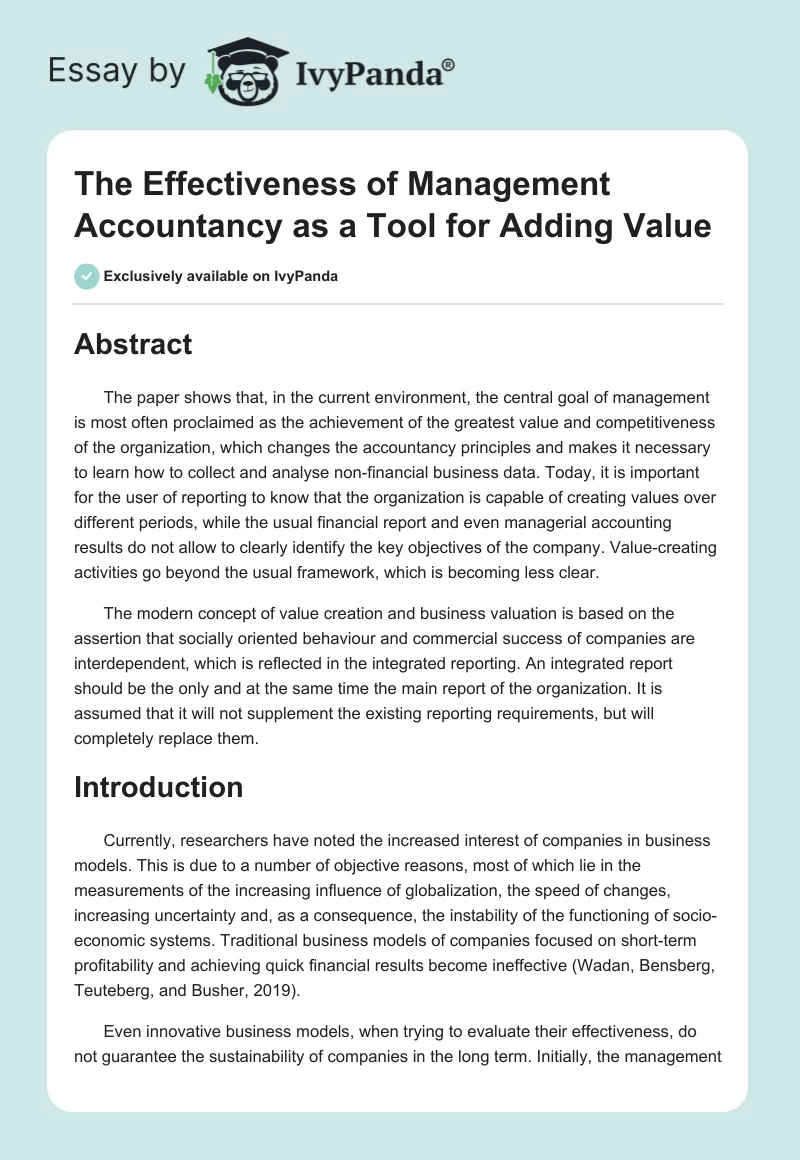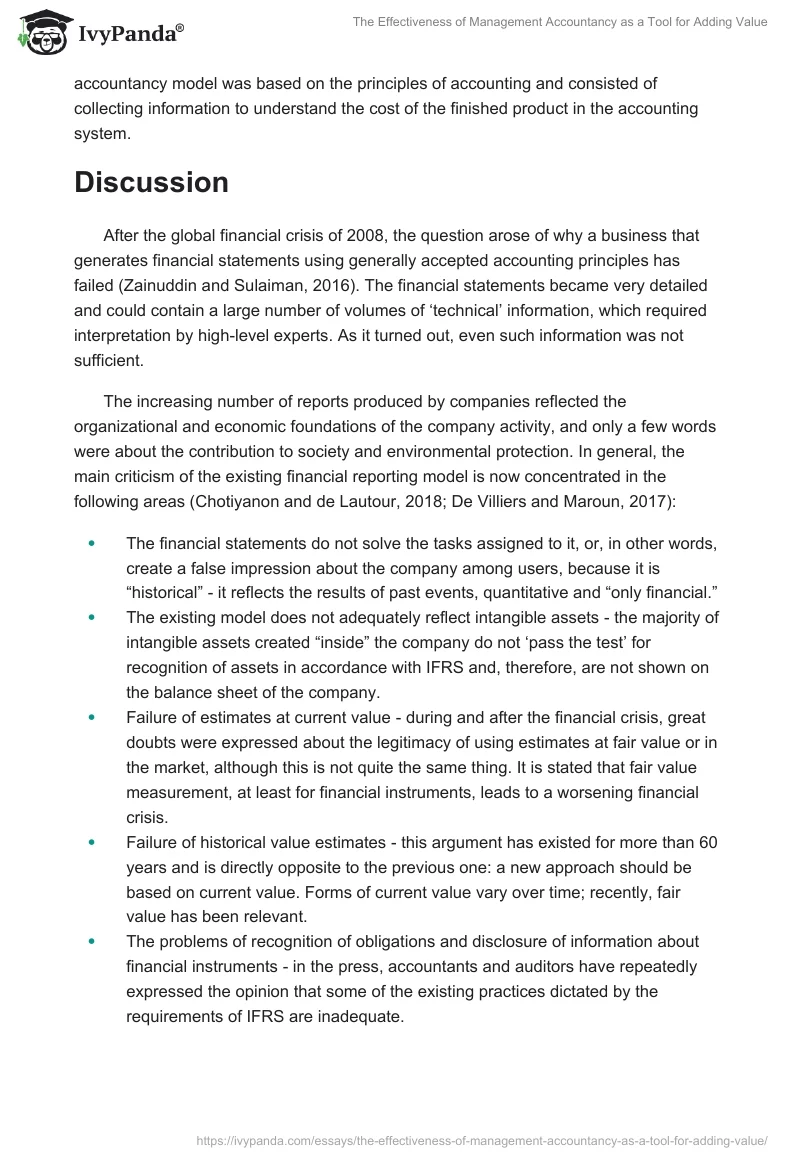Abstract
The paper shows that, in the current environment, the central goal of management is most often proclaimed as the achievement of the greatest value and competitiveness of the organization, which changes the accountancy principles and makes it necessary to learn how to collect and analyse non-financial business data. Today, it is important for the user of reporting to know that the organization is capable of creating values over different periods, while the usual financial report and even managerial accounting results do not allow to clearly identify the key objectives of the company. Value-creating activities go beyond the usual framework, which is becoming less clear.
The modern concept of value creation and business valuation is based on the assertion that socially oriented behaviour and commercial success of companies are interdependent, which is reflected in the integrated reporting. An integrated report should be the only and at the same time the main report of the organization. It is assumed that it will not supplement the existing reporting requirements, but will completely replace them.
Introduction
Currently, researchers have noted the increased interest of companies in business models. This is due to a number of objective reasons, most of which lie in the measurements of the increasing influence of globalization, the speed of changes, increasing uncertainty and, as a consequence, the instability of the functioning of socio-economic systems. Traditional business models of companies focused on short-term profitability and achieving quick financial results become ineffective (Wadan, Bensberg, Teuteberg, and Busher, 2019).
Even innovative business models, when trying to evaluate their effectiveness, do not guarantee the sustainability of companies in the long term. Initially, the management accountancy model was based on the principles of accounting and consisted of collecting information to understand the cost of the finished product in the accounting system.
Discussion
After the global financial crisis of 2008, the question arose of why a business that generates financial statements using generally accepted accounting principles has failed (Zainuddin and Sulaiman, 2016). The financial statements became very detailed and could contain a large number of volumes of ‘technical’ information, which required interpretation by high-level experts. As it turned out, even such information was not sufficient.
The increasing number of reports produced by companies reflected the organizational and economic foundations of the company activity, and only a few words were about the contribution to society and environmental protection. In general, the main criticism of the existing financial reporting model is now concentrated in the following areas (Chotiyanon and de Lautour, 2018; De Villiers and Maroun, 2017):
- The financial statements do not solve the tasks assigned to it, or, in other words, create a false impression about the company among users, because it is “historical” ‑ it reflects the results of past events, quantitative and “only financial.”
- The existing model does not adequately reflect intangible assets ‑ the majority of intangible assets created “inside” the company do not ‘pass the test’ for recognition of assets in accordance with IFRS and, therefore, are not shown on the balance sheet of the company.
- Failure of estimates at current value ‑ during and after the financial crisis, great doubts were expressed about the legitimacy of using estimates at fair value or in the market, although this is not quite the same thing. It is stated that fair value measurement, at least for financial instruments, leads to a worsening financial crisis.
- Failure of historical value estimates ‑ this argument has existed for more than 60 years and is directly opposite to the previous one: a new approach should be based on current value. Forms of current value vary over time; recently, fair value has been relevant.
- The problems of recognition of obligations and disclosure of information about financial instruments ‑ in the press, accountants and auditors have repeatedly expressed the opinion that some of the existing practices dictated by the requirements of IFRS are inadequate.
Authoritative sources indicate the fact that the business itself must begin reforming approaches to business models and assessing the value of the business (Katsikas, Rossi, and Orelli, 2017), as well as a modification of the approach to the essence of management accounting. It is known that management accounting uses not only actual data on completed operations, but also estimates (analytics), data on possible future events (plans and budgets). Management accounting provides information to users not only in monetary terms and not only quantitative, but also qualitative (which of the types of activities or departments is the most profitable and, most importantly, why).
Integrated reporting is transparent information focused on creating the value of the organization both in the long and short term, while explaining in a very simple manner how all the elements (financial and non-financial) form a single whole. The achievement of both social and economic progress must take into account the principles of value creation (Babajide, Imoleayo, and Uwalomwa, 2015). The first attempts to change the vision in the value chain are related to the development of the concept of business social responsibility (CSR). Recently, it is one of the most developed concepts in economics and management, which passed a path of more than 50 years since the first publication on social responsibility issues.
Most researchers interpret social responsibility as voluntary assistance of business to society through the implementation of socially significant projects and programs. It includes participation in solving vital issues in the field of ecology and environmental protection, health protection, education, and the development of territories where companies are present (Prowle and Lucas, 2017). Researchers also highlight the components (directions) of socially responsible behaviour that affect the value creation process, presented below. Despite its debatability and ambiguity, as well as social norms and principles “imposed” from above, this concept first drew the attention of the business community to the need to take into account the interests of not only shareholders and consumers, but also society as a whole:
- Responsibility to society, employees, partners, and consumers; production of high quality products;
- Openness and accessibility for society in all aspects of activities that do not constitute a trade secret; compliance with legal requirements;
- The priority of solving social problems, both at the company level and at the level of society as a whole;
- The active use of all initiatives aimed at developing a business and improving the social climate.
The first integrated reports in the world began to appear in the mid-2000s. In 2007, at the international annual reporting contest Corporate Register, the nomination “Best Integrated Report” appeared. In 2007, an initiative of the Prince of Wales, Accounting for Sustainability, the Connected Reporting Framework was introduced (Smith, 2018). Companies, investors, and governments are beginning to realize that long-term sustainable operation is based on an understanding of the interdependence of financial, social, and environmental factors. In order to create and maintain value in the future, organizations must ensure sustainability as part of their overall strategy and decision-making processes, which should be reflected in management accountancy.
The idea of integrated accounting and reporting is consonant with time, the level of development of information technologies, concentration of capital, the degree of business responsibility to society; therefore, it deserves attention and comprehensive study. The analysis reveals the existence of many approaches to the definition of this concept. This diversity is explained by the fact that most authors pay attention to various aspects of economic sustainability ‑ financial, investment, marketing, and production (Katsikas, Rossi, and Orelli, 2017). The systematization of existing points of view allows distinguishing two main areas in determining corporate sustainability.
The first approach is dynamic; it determines the stability of the enterprise from the position of its ability to adapt to the dynamics of factors of the external or internal environment. The second approach is static, which determines corporate sustainability from the perspective of the results of the financial and economic activities of the enterprise (Chotiyanon and de Lautour, 2018). Thus, the sustainable development of companies (corporate sustainability) involves focusing on the basic interests and needs of key stakeholders. Namely they influence the company, determining its access to resources and the value of the company in the eyes of investors.
The main goal of compiling integrated reporting is to provide a concise summary of all the company’s activities in relation to each other and to explain to investors and founders who are suppliers of financial capital, how the company generates value over time. Increasingly more attention is being paid to alternative methods of selecting resources, formal and informal types of business cooperation, and other innovations that blur the boundaries.
For example, now the end customer can be a supplier at the same time, as he can make a rationalization contribution to the development of new products. Globalization, demographic changes, the transition to digital technologies are the main trends affecting the expansion of the value chain. Moreover, reputation is what runs the thread through all aspects of ethics, management, and the risks of the entire extended value chain. Therefore, in the implementation of management accounting, organizations should pay great attention to this linking characteristic.
Conclusion
Today, reputation should be mandatory component of a risk management system. This is especially important if to consider that 80% of the value of modern organizations is represented by intangible assets (which also includes brand value), which can be seriously affected by a blow to reputation (Smith, 2018). That is why organizations need to pay close attention to the risks of third parties ‑ both in the supply chain and in key relationships.
The new integrated reporting model is seen as an opportunity to get a more complete picture of the activities of the company, which reflects risks and opportunities, while more logically linking the Environmental, Social, and Governance (ESG) factors and the company’s financial results. The key objectives of introducing the concept of integrated reporting is to reflect the relationship between financial factors and ESG factors in making decisions that have a significant impact on the long-term results of a business by reflecting a clear and transparent relationship between business sustainability and its economic value.
Reference List
Babajide, O., Imoleayo, O., and Uwalomwa, U. (2015) ‘Should integrated reporting be incorporated in the management accounting curriculum?’ International Journal of Education and Research, 3(1), pp. 63-76.
Chotiyanon, P. and de Lautour, V. J. (2018) The changing role of the management accountants: becoming a business partner. London: Palgrave Macmillan.
De Villiers, C. and Maroun, W. (2017) Sustainability accounting and integrated reporting. Abingdon: Routledge.
Katsikas, E., Rossi, F. M., and Orelli, R. L. (2017) Towards integrated reporting. New York: Springer.
Prowle, M. and Lucas, M. (2017) Management accounting in the contemporary business world. London: Red Globe Press.
Smith, S. S. (2018) Integrated reporting management: analysis and applications for creating value. New York: Productivity Press.
Wadan, R., Bensberg, F., Teuteberg, F., and Busher, G. (2019) ‘Understanding the changing role of the management accountant in the age of industry 4.0 in Germany,’ Proceedings of the 52nd Hawaii International Conference on System Sciences, pp. 5817-5826.
Zainuddin, Z. N. and Sulaiman, S. (2016) ‘Challenges faced by management accountants in the 21st century,’ Procedia Economics and Finance, 37, pp. 466-470.


